David Alfaro Siqueiros: biography and works of the Mexican muralist
The painter David Alfaro Siqueiros was one of the highest representatives of Mexican muralism along with José Clemente Orozco and Diego Rivera. He displayed a fierce temperament, always convinced of the importance of art as a vehicle for the formation of popular consciousness through a large theoretical work.
At the same time, he stood out for being the most risky of the muralists on an aesthetic and technical level, since he did not limit himself to fresco. On the contrary, he investigated the use of new materials such as fiberglass and techniques such as sculpture-murals.
How were man, painting and politics integrated in Siqueiros? A review of his life, work, style, techniques and theoretical texts of him will allow us to better understand this distinguished representative of muralism.
Biography of David Alfaro Siqueiros

José de Jesús Alfaro Siqueiros, better known as David Alfaro Siqueiros, was born on December 29, 1896. There is no clarity of the place of birth. Some sources indicate that he was born in Chihuahua and others in Mexico City. His parents were the lawyer Cipriano Palomino Alfaro and Teresa Siqueiros Feldman, a housewife, practicing deep Catholicism.
When he was just a child, he demonstrated his interest and talent for painting by painting in 1907 a replica of the Virgin of the Chair by Rafael. Four years later, in 1911, he began studies of architecture at the National Preparatory School, while taking night classes at the Academia San Carlos (National School of Fine Arts).
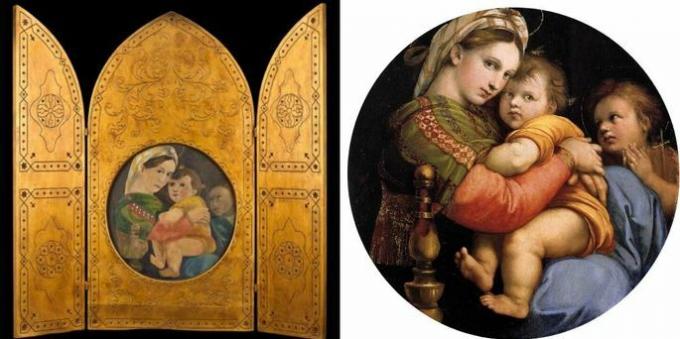
Right: Rafael Sanzio: Virgin of the Chair, 1514, oil on canvas, Pitti Palace, Italy.
Siqueiros' activist spirit made its first appearance when he first participated in a strike against the teaching methods of the academy. After stoning the director, Rivas Mercado, Alfaro Siqueiros was arrested. Later, in 1913, he enrolled in the Outdoor School in Santa Anita.
At the age of 18, Siqueiros enlists in Venustiano Carranza's Constitutionalist Army, and writes for the informative body The vanguard. In the same year, 1914, he married Graciela Amador, nicknamed Gachita. Some say that Gachita suggests adopting the name David in reference to Michelangelo's sculpture, but this hypothesis has not been confirmed.
An artistic-political ideology is born
In those years, the government of Álvaro Obregón encouraged and favored the idea of public and propaganda art at the service of the nation. This ideology was shared by teachers like Dr. Atl and, in this way, it was infused into the next generation, which included Siqueiros.
In 1919, the young painter traveled to Europe. First he goes to Paris, where he meets Diego Rivera. Then he heads to Italy, where he studies the great masters of the Renaissance and the Baroque. He also receives a scholarship to study in Spain. In 1921, he published the text entitled "Three calls to the plastic artists of America" for the magazine American life. This will be the first in a series of theoretical, ideological and aesthetic texts that will mark his artistic and political work.
Siqueiros and Mexican muralism

In 1922, David Alfaro Siqueiros returned to Mexico. Under the government of Álvaro Obregón and the protection of José Vasconcelos, secretary of education, he begins his work as a muralist with Diego Rivera, José Clemente Orozco and other artists recognized. In 1923 he founded the Union of Workers, Technicians, Painters and Sculptors (SOTPE). Regarding this union, researcher Alicia Azuela de la Cueva maintains that:
His affiliates were in favor of a form of public, educational and propaganda art at the service of the majority, committed to the social and political problems of the moment. Siqueiros played an important role in this process that had to do with the definition of the principles union members, their social functions and with the redefinition of relationships with groups of can.
Dissatisfied with the first manifestations of muralism, Siqueiros reflects on and radicalizes his position regarding the meaning and purpose of public art. He thus creates the Union of Revolutionary Mexican Painters, Sculptors and Engravers, and directs the informative body The Machete, with time it becomes a means of the Mexican Communist Party. In this, he publishes the "Manifesto for a collective art" of 1923.
Politics in the life of Siqueiros
The militancy of the muralists in the Communist Party of Mexico (PCM), makes them increasingly critical of the government. Consequently, the government stops financing mural projects, which in some cases exposes artists to precariousness. After this turn of events, Siqueiros assiduously commits himself to the political activity of the PCM and participates in different agitation activities.

In 1929, the artist was sent as a representative of the PCM to the Latin Americanist Trade Union Congress in Montevideo. There he met the Uruguayan writer Blanca Luz Brum and began a relationship that would last six years. This meant the end of his marriage to Gachita in 1929 and, later, his expulsion from the party. The cause must be sought in the context of Mexico upon the return of Siqueiros.
By 1930, the Cristero revolution and the assassination of Obregón had spurred political persecution and the outlawing of the PCM. The party saw in everyone a threat of espionage. Siqueiros' new partner, Brum, was the target of such suspicions. Refusing to break his relationship with the writer, the PCM decided to expel Siqueiros. The measure was justified as a way to protect the artist from the political persecution that hung over the PCM.
From prison to Taxco, a step for artistic renewal
Around 1930 Siqueiros participated in the May Day parade, which ended in confrontation with the authorities. The artist was arrested and charged with instigating the rebellion. After a few months in prison in Mexico City, he was sent to the city of Taxco on parole.
His stay in Taxco allowed him to meet international cultural figures, such as the architect American William Spratling and the filmmaker Sergei Eisenstein, the greatest exponent of Russian formalism. The filmmaker fostered in the painter the idea of subversive art at the service of the proletariat, as well as the revolutionary experimental and scientific character.
Siqueiros' first exile
In Taxco, the artist began to make some easel paintings, despite the fact that he politically opposed the medium, considering it private and bourgeois. Siqueiros found an excuse to obtain permits to visit Mexico City, on account of some exhibition.
Over time, Siqueiros achieved exile. His first stop was Los Angeles in 1932, where he remained active as a prestigious muralist, thanks to the diplomatic work of Dwight Morrow, US ambassador. in Mexico. However, the artist's political belligerence cost him expulsion from the northern country, which led him to Montevideo and Buenos Aires.
The anti-fascist struggle and the Spanish Civil War
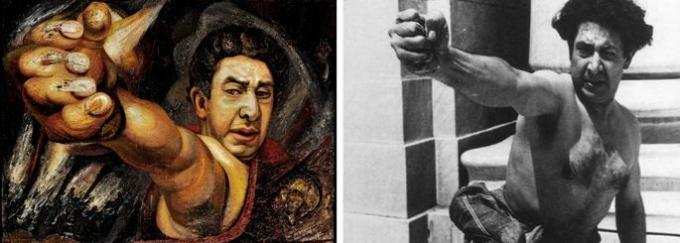
Right: photographs for perspective study in The coronelazo.
Siqueiros returned to Mexico in 1934 and was part of the National League against Fascism and War. In 1935, he divorced the writer Blanca Luz Brum. In 1936, he enlisted as a volunteer in the Spanish Civil War, in the service of the Second Republic. He obtains the rank of lieutenant colonel, for which he receives the alias "El Coronelazo", the name of his best-known self-portrait of him.
He returns to the United States at the end of the war. There he founded the Siqueiros Experimental School in New York. He develops various exhibitions, conferences and workshops, and has collaborators such as Jackson Pollock and Oscar Quiñones.
Siqueiros married Angélica Arenal in Spain in 1938, who remained by his side until her death. From that marriage an only daughter was born, named Adriana Alfaro Arenal.
Back in exile
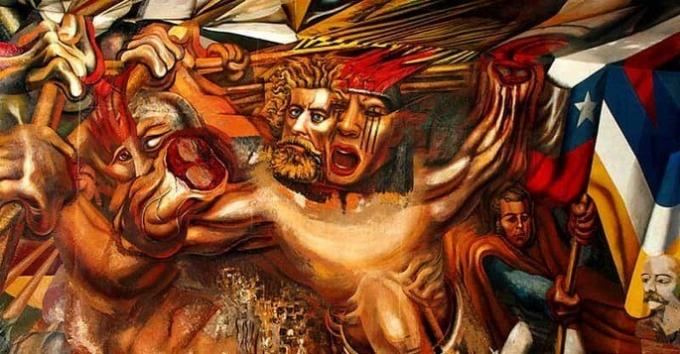
When he returns to Mexico, Siqueiros organizes in 1941 an attack against Trotsky, the Russian leader enemy of Stalin, and a refugee in Mexico under the protection of the Rivera-Kahlo.
The attack against Trotsky costs Siqueiros a new exile. He finds refuge in the city of Chillán, in Chile, between 1941 and 1943. During this stage, he elaborates different works for the Chilean and Cuban governments. Alicia Azuela de la Cueva maintains that the experience of exile:
… Not only did he permanently seal the relationship between his artistic career and his political activity, but also gave them, in their content and impact, a broad international and cross-cultural character.

Far from what one might think, exile was a more than convenient policy for the Mexican government. Azuela adds:
… The value of his artistic work allowed him to receive special treatment from the Mexican government, which instead of imprisoning him exiled him. In this way, he benefited from the absence of the painter, who gave the nation prestige with his artistic work, but by being absent he did not subvert the established order.
Thus, his political activism and his outstanding artistic work conspired favorably in the process of international consecration of the muralist.
Back to mexico

Back in Mexico in 1944, Siqueiros continued his career as a muralist and his work as an art theorist and ideologist, which was reaffirmed with the publication of the book There is no other route than ours.
While he held the position of president of the Committee of Political Prisoners and the Defense of Liberties Democratic, Siqueiros is accused of social dissolution and is sentenced to prison in Lecumberri from 1959 to 1964. Although his ongoing mural projects remain unfinished, this long period in prison allows him to explore easel painting anew.
However, his moment of greatest artistic glory awaits him when he is released from prison: the mural painting project for the Polyforum in Mexico City. In this project, produced in his most mature stage, the artist consolidates his consecration as a representative of Mexican culture.
David Alfaro Siqueiros died on January 6, 1974, affected by the cancer disease.
It may interest you:
- Mexican muralism: characteristics, authors and works.
- José Clemente Orozco: biography, works and style of the Mexican muralist.
Main works of David Alfaro Siqueiros
Next, let's get to know some of the most important mural works by David Alfaro Siqueiros, organized chronologically.
The elements (1922)

The elements it was the first mural by David Alfaro Siqueiros. It was a commission from the government, which had summoned several artists to decorate the National Preparatory School, the former convent of San Ildefonso. The surface chosen by Siqueiros is the vault of the staircase of the Colegio Chico de la ENP, which represents a rather unique choice. According to researcher Guillermina Guadarrama Peña, the mural reveals the influence of Byzantine-Renaissance art.
Portrait of the bourgeoisie (1939)
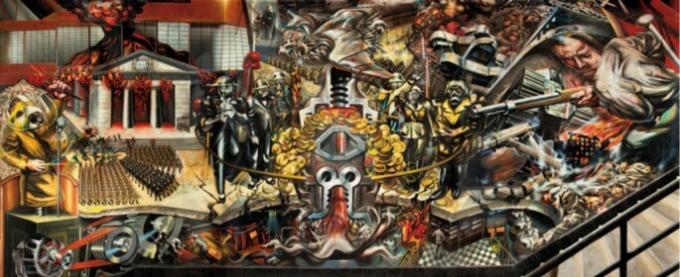
Portrait of the Bourgeoisie It was made to decorate the Mexican Electrician Union, during a period that coincides with its anti-fascist activism. It is this intention or denunciation of the fascist and capitalist order that is reflected in the mural.
Triptych The new democracy (1945)

Probably the triptych The new democracy, exhibited at the Palacio de Bellas Artes, is the painter's best-known work. The central panel is flanked on the left by the scene Victims of war and, on the right, by Victims of fascism. The work was executed on a free wall. In it, Siqueiros used polyangularity to take advantage of the different viewing angles within the enclosure.
From porfirismo to revolution (1957-1966)

From porfirismo to revolution it was a commission for the National Museum of History. It is a work that occupies all the walls of the space with various scenes from the historical journey in question. Therefore, the narrative character predominates over the symbolic character.
The people to the University, the University to the people (1956)
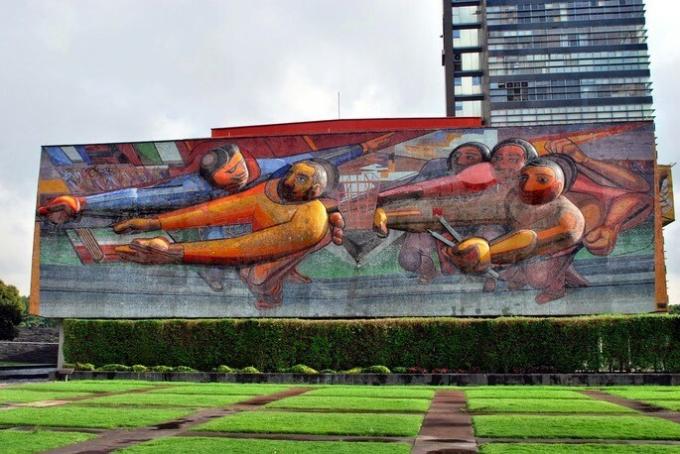
The full name of this mural is The people to the University, the University to the people. For a neohumanist national culture of universal depth. It was prepared between 1952 and 1956 for the Autonomous University of Mexico. This work marks an important milestone, due to the magnificent development of a revolutionary technique: the sculptural. The work is just one of the three facades intervened by Siqueiros, among which are The right to culture Y New university symbol.
The march of humanity (Polyforum Siqueiros, 1965-1971)

The Polyforum Siqueiros mural ensemble is the masterpiece of this Mexican muralist. The total sum of the surfaces intervened by the painter, both interior and exterior, makes The march of humanity the largest mural work in the world. In this sense, it represents an effort analogous to that of Michelangelo's Sistine Chapel. It expresses the political conviction of Siqueiros on the march of humanity towards full freedom.
He may also interest you: 5 fundamental works of Diego Rivera.
Style of David Alfaro Siqueiros

Siqueiros positioned himself against currents of art such as picturesqueism or primitivism, since they restricted the universal value of Latin American art.
A staunch defender and promoter of the political and aesthetic values of Mexican muralism, he opted for a truly democratic public art. Therefore, in the Manifesto of the Union of Technical Workers, Painters and Sculptors, Siqueiros writes:
We repudiate the so-called easel painting and all ultra-intellectual cenacle art as aristocratic, and we exalt the manifestations of monumental art as being of public utility.
The revolutionary spirit of this muralist transcended the contents and, in addition to committing to the communication medium (the wall), he dealt with the importance of scientific and technical research in the art. For this reason, Siqueiros was extremely innovative from the plastic point of view.
The features of the work of David Alfaro Siqueiros can be summarized as follows:
- Preference for the mural.
- Monumentality.
- Breakdown of static geometry.
- Dynamism and movement.
- Polyangularity. Combination of different planes and sizes in a single work to create better views according to the visual angle.
- Use of close-ups.
- Foreshortening as a plastic-expressive element.
- Aggressive development of volume and line.
- Intense coloring.
- Trend to Horror vacui or overloaded surfaces.
Along with this, the following stand out singularly contributions technical and plastics:
- Exploration of unconventional and irregular wall spaces. For example, inside the stairs, public transport stops, etc.
- Exploration of new techniques. For example, sculptural painting.
- Exploration of new materials, such as mosaics, glass cloth, jute, cement, acrylic, enamel, ceramic, industrial paints, celotex, wood chip, etc.
- Support in photography as a visual study resource.
Stages of David Alfaro Siqueiros
In a text entitled Siqueiros' route: stages in his mural work, the researcher Guillermina Guadarrama Peña distinguishes five stages of Siqueiros' mural work:
First stage
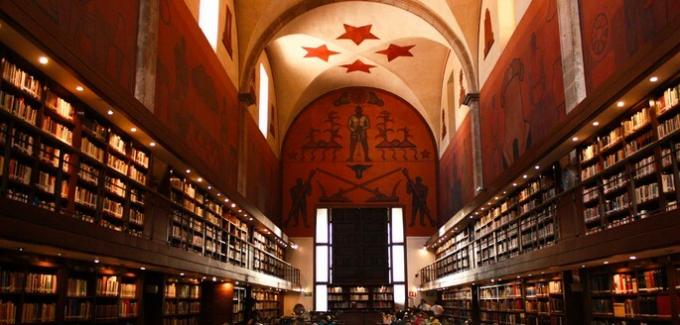
He covers his first muralist works from about 1922 to 1931, beginning at the invitation of the government. The era of great activism and the awakening of the social conscience of art begins. In his early works the influence of the Renaissance murals that he studied in Italy is felt. Little by little, his political vision modifies his artistic activity.
Some of the important works of this period are:
- The elements, 1922. Former Colegio Chico of the National Preparatory School, today Colegio San Ildefonso, Mexico.
- Agrarian and Labor Ideals of the 1910 Revolution, 1925-1926. Iberoamerican Library, Mexico.
Second stage

The second stage ranges from 1931, when he began his first exile, until the attack against Trotsky in 1941. Influenced by his new experiences and the learning gained from contact with international artists, he understands that political vision must be linked to technical innovation.
Among the works of Siqueiros corresponding to the second stage we can count:
- Rally in the street or Worker rally, 1932. Los Angeles, USA
- Tropical America oppressed and torn apart by imperialism, 1932. Los Angeles, USA
- Current portrait of Mexico, 1932. Private house. Los Angeles, USA
- Plastic exercise, 1933. Casa Rosada Museum of Buenos Aires, Argentina.
- Portrait of the bourgeoisie, 1939-1940. Staircase of the Mexican Electrician Union headquarters, Mexico City.
Third stage

It begins with his exile, in 1941, until approximately 1951. It is marked by his belligerent anti-fascism. The struggle between the oppressed and the oppressors dominates Siqueiros' thematic horizon.
Some of Siqueiros' mural works in the third stage are:
- Death to the invader, 1941-1942. Mexico School, City of Chillán, Chile.
- New democracies day Y Two mountains of America (Cuba), 1943.
- Allegory of the equality and fellowship of the black and white races (Cuba), 1943. Destroyed.
- Cuauhtémoc against the myth, 1944. Tecpan, Mexico.
- Triptych The new democracy, 1945. Palace of Fine Arts, Mexico.
- Patricians and patricians, 1944-1972. Secretary of Public Education (former customs), Mexico City.
- Monument to General Ignacio Allende, 1949. San Miguel de Allende, unfinished.
- Apotheosis of Cuauhtémoc, 1950-1951. Palace of Fine Arts, Mexico.
- Cuauhtémoc's torment, 1951. Palace of Fine Arts, Mexico.
Fourth stage
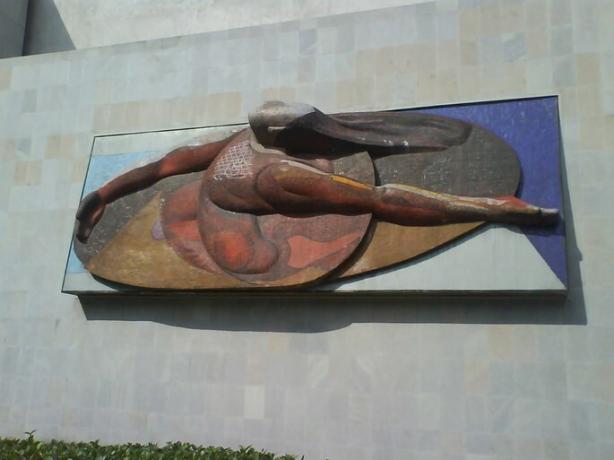
The fourth stage spans roughly from 1951 to the early 1960s. He continues the work of technical experimentation and develops truly innovative proposals such as the sculptural murals. He also develops easel painting during his seclusion in Lecuberri.
Some of the important works of this period are:
- The man master and not slave of the technique, 1951. National Polytechnic Institute, Mexico.
- For complete social security and for all Mexicans, 1951-1954. Hospital de la Raza, Mexico.
- The people to the University, the University to the people. For a neohumanist national culture of universal depth, 1952-1956. Autonomous University of Mexico.
- The right to culture (The dates of Mexico) and New university symbol, 1952-1953, Autonomous University of Mexico (unfinished).
- Velocity, 1953. Plaza Juárez, Mexico.
- Excommunication and execution of Hidalgo, 1953. Michoacan University of San Nicolás de Hidalgo, Michoacán, Mexico
- Apology for the future victory of medical science against cancer. Historical parallelism of the scientific revolution and the social revolution, 1958. XXI Century Medical Center, Mexico City.
- From Porfirism to the Revolution, 1958-1966. Siqueiros Room of the Castle of Chapultepec, Mexico.
- The scenic art in front of the social life in the Mexico of today, 1959-196. Lobby of the National Association of Actors, Mexico City.
Fifth stage
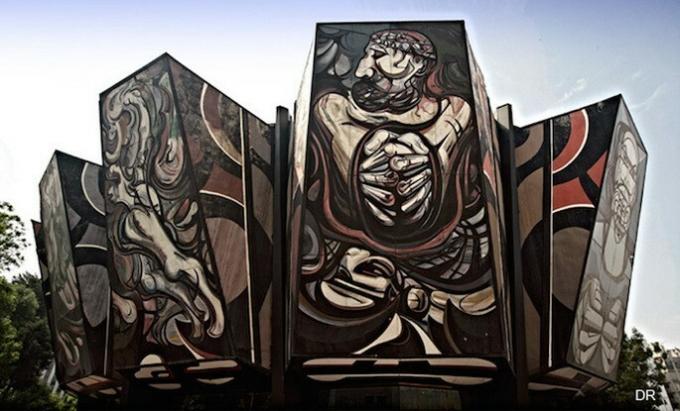
It covers between 1965 and 1971. Among other works, Siqueiros develops the work that would consecrate him in history: the Polyforum in Mexico City, which will end up bearing his name. The Polyforum becomes a synthesis of all his artistic and political vision. For Guillermina Guadarrama Peña, it is the period of totalizing plastic integration.
Some of the important works of this period are:
- The march of humanity, 1965-1971. Polyforum.
- Oil, land like water and industry forge us and belong to us, 1966. Soumaya Museum, Mexico City.
- Copiapó Landscape, 1972. Copiapó Elementary School, Vicente Guerrero Housing Unit, Mexico City.
Basic texts of David Alfaro Siqueiros
- "Three appeals of current artistic orientation to the painters and sculptors of the new generation", published in the magazine American life from Barcelona, 1921.
- "Manifesto of the Union of Technical Workers, Painters and Sculptors", published in the informative body The Machete, 1923.
- "The vehicles of dialectical-subversive painting". Lecture delivered on September 2, 1932 at the John Reed Club in Los Angeles, California, USA.
- Manifesto "In war, art of war!" Published on January 18, 1943 in Santiago de Chile, in the newspapers The nation, The time and El Siglo, and in the magazine Shape.
- How to paint a mural. Mexico. 1951.
- There is no route like ours. National and international importance of modern Mexican painting. The first outbreak of profound reform in the visual arts of the contemporary world. Compilation. Mexico, 1945.
- To a young Mexican painter, Mexico: Editorial Companies, 1967.
- They called me the coronelazo. Memoirs of David Alfaro Siqueiros, Mexico, Grijalbo, 1977.
Awards and honours
- 1950: Venice Biennale Award.
- 1966: Lenin Peace Prize. The money received was donated to Vietnam during the war with the United States. USA
- 1966: National Prize of Fine Arts of Mexico.
- 1971: In recognition of his career and the value of the Polyforum murals, the government names the cultural complex in his honor as Polyforum Siqueiros.
References
- Guillermina Guadarrama Peña: Siqueiros' route: stages in his mural work, Mexico: National Council for Culture and the Arts, 2010.
- De la Cueva, Alicia Azuela: Political Militancy and Artistic Work by David Alfaro Siqueiros: from Olvera Street to Río de la Plata. Stud. hist. mod. contemp. Mex no.35 Mexico Jan./Jun. 2008.
- Ortiz Gaitán, Julieta: David Alfaro Siqueiros. Easel painting by Xavier Moyssén. An. Inst. I investigated. Estét vol.23 no.78 Mexico Mar./May. 2001
- Alfaro Siqueiros, David: "Three appeals of current artistic orientation to the painters and sculptors of the new generation", published in the magazine American life from Barcelona, 1921.
- Alfaro Siqueiros, David: "Manifesto of the Union of Technical Workers, Painters and Sculptors", published in the informative organ The Machete, 1923.
- Alfaro Siqueiros, David: "The vehicles of dialectical-subversive painting". Lecture delivered on September 2, 1932 at the John Reed Club in Los Angeles, California, USA.



